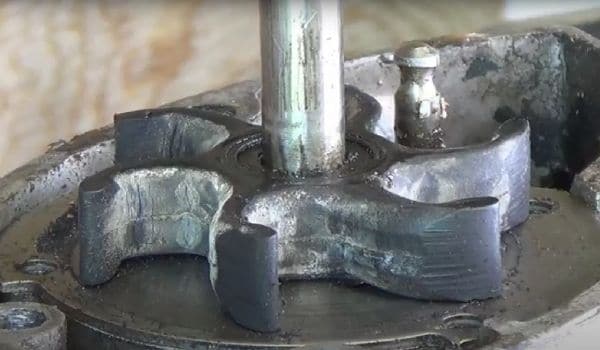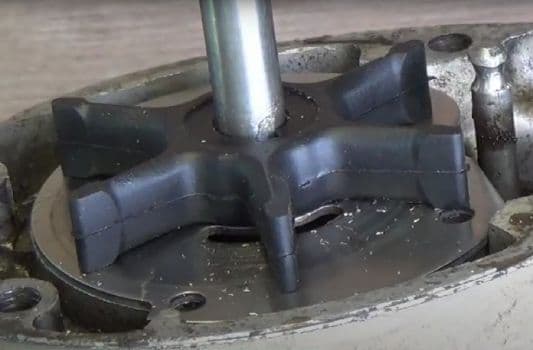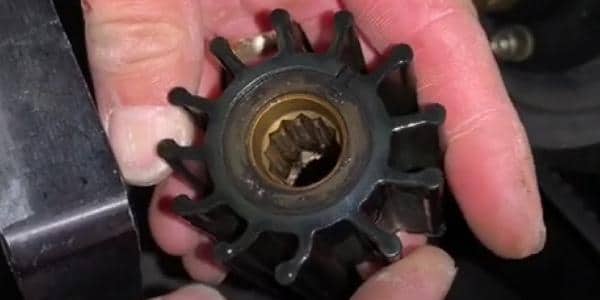A boat impeller pumps raw water from outside a marine engine into the engine’s cooling system (source). The featured image above shows what it looks like. Impellers are usually located in the lower unit for outboards and sterndrives and on the engine for inboards.
A boat impeller needs to be replaced if its fins are curved, cracked, melted, or worn out. Most marine engine brands recommend replacing impellers once every 300 hours or 3 years, but they should be inspected once every year.
You may also need to replace your water pump housing every 300 hours as well. This is what holds your impeller in place.
Here’s an example of an impeller that needs to be replaced:

Notice how its fins are extremely curved. This causes less water pressure, which results in higher engine temperatures. Also, if you look closely at the fin on the left, it’s starting to crack, meaning that this impeller is at risk of breaking.
A brand new impeller should look like this:

Obviously, this impeller has much straiter fins and is not cracking. This will allow better water flow through the engine cooling system.
In order to check for damages on your impeller, you’ll need to expose it by taking parts off of your engine. However, if you don’t want to do that quite yet, there are other signs to look for to tell if your impeller is bad as I explain below.
How to tell if your boat impeller needs to be replaced?
Here’s a list of all of the signs that your impeller needs to be replaced.
- Impeller wear and tear. It’s usually pretty obvious to see wear and tear but look for cracks, bends, and melted rubber.
- Engine overheating. Make sure to check your temperature gauges often if you believe you have a bad impeller. 160°F (71°C) is the hottest gasoline engines should run. Diesel engines shouldn’t run any hotter than 200°F (93°C).
- Engine smoking. This goes hand to hand with an overheating engine, but when an engine overheats it could burn oil and cause your engine to smoke.
- Reduction in engine pee. If you’re noticing a weeker water stream coming out of your engine, it may be because your impeller is going bad and there is less water being pressured through it.
- Engine sounds hollow. Water pressured through your engine by the impeller is used to aid in muffling your engine. So if your engine sounds unusually loud and hollow, it’s probably because there’s no water running through it.
- Impeller hasn’t been replaced in over 300 hours. Most manufacturers recommend changing your impellers every 300 hours and checking them once a year, but it’s always best to check your exact owner’s manual.
Click on links to learn more.
I usually take a picture of how strong of a tell-tail (engine pee) I have when the impeller is brand new so that way I can always compare how it is now to the picture as the impeller ages and the stream gets weaker. Note that there could be other factors affecting your engine stream strength.
Continue reading to get a better understanding of each of these signs.
Impeller wear and tear

As you can see, the impeller to the left is severely curved and slightly cracked. If your impeller looks like that, I would recommend replacing it immediately. However, if your impeller fins are only slightly curved or bent, and there is no cracking or melting, you could probably get another season out of it without running into any problems.
And when I mean a slight curve, I mean barely a curve at all.
Not all impellers look exactly like the ones above. Many times impellers for inboard engines will have much shorter fins such as the one below. On these impellers, if you notice any sort of curve or bend, I recommend replacing it. The shorter fins make it less likely to curve, but you know it’s a sign to replace it once it does curve.

Although most of the fins on the impeller above are straight, notice the curved one on the bottom. Because of just that one, I would recommend replacing this impeller. One curved fin on these short fined impellers will cause significantly less water pressure through the cooling system.
Note that sometimes a fin may appear curved while it’s sitting inside its casing; however, it straitens up when you pull it out. If this is the case, you don’t need to replace the impeller.
Engine overheating
According to Sweet Ruca, a failed impeller is the third most common reason for engine overheating. One and two are a clogged water strainer and debris stuck in the intake. So, if there isn’t anything clogged in your strainer or intake, your engine is probably overheating due to a bad impeller.
Most boats have a temperature gauge to read engine temperature and a warning system that will alert you if your engine is overheating. If you need to install a temperature reader, check out this video or contact a boat mechanic.
If no warning goes off, your engine will eventually burn oil and start to smoke. Hopefully, it won’t get to that point as it could severely damage your engine.
Reduction in water pressure (reduction in engine pee)
Reduction in water pressure goes hand to hand with an overheating engine. When there’s less water pressure, your engine will run hotter. So when checking water pressure, make sure nothing is clogged in your strainer or intake as those 2 are the most common cause of poor engine water pressure.
The third most common reason is a damaged impeller. So before you blame the impeller, make sure you check for clogs.
The best way to check for water pressure is to just look at your engine tell-tail (engine pee). If the stream is weak or non-existent, something is wrong and you need to fix it. Below is an example of a good engine tell-tail:

A good way to determine a weak stream is to take a picture of it when the engine is running normally, then compare it to what the stream looks like later.
Another thing that could happen if there is no or low water pressure is your engine will sound hollow and loud.
Impeller hasn’t been replaced in over 300 hours
As I’ve mentioned above, most boat manufacturers recommend changing your impeller and impeller casing once every 300 hours or 3 years. However, if you use your boat motor very often, such as on a company boat, you may want to change it once every 150 hours as it may wear down quicker.
Always make sure what your owner’s manual says on how often you should replace your impeller as not every motor is the same. Especially marine diesel motors tend to have vastly different recommendations when it comes to stuff like this.
What causes your boat impeller to wear out
General usage is the main cause of wearing out your boat impeller, but there are some things that wear them out quicker. These are:
- Sucking up sand or mud into your intake. When you suck up anything besides water in your engine, it could damage your impeller. Sand and mud are very abrasive and could scratch an impeller or get stuck inside it.
- Too much dry storage. The rubber that makes up impellers can dry if you don’t run water through it often. There’s obviously nothing you can do for offseason storage, but if you dry store your boat all year long and barely take it out, don’t be surprised when your impeller starts to crack due to being dry.
- Running your boat out of the water. Water acts as the primary lubricant for your impeller. So if you ever run your motor out of the water (even for just a little bit), it will wear out your impeller.
When should you replace your boat impeller?
You should replace your boat impeller once every 300 hours or every 3 years. The best time to replace it is during winterization. This is because if you have an outboard or I/O, you will need to drain out lower unit oil before you can get access to the impeller. During winterization, you usually drain this oil out anyways.
You can change the impeller yourself fairly easily. Some owner manuals may have instructions; otherwise, there are plenty of YouTube videos to teach you how to do it. Click here to scroll down to the subheading titled “How do you replace a boat impeller?”.
Otherwise, a boat mechanic can replace your impeller for around $250. Generally, you’ll add this service to your usual winterization maintenance. You may also want to replace your water pump housing during this time.
I recommend keeping your old impeller (if it’s not completely worn out) with you in case you need to replace your new one in an emergency.
What happens if your boat impeller fails?
If your boat impeller were to break during boat operation, no cold water would get pumped through your engine. This would cause your engine to overheat rapidly. An overheated engine could seize up, warp metal, burn oil, and cause the head to blow.
The impeller could also break up into rubber pieces and get stuck throughout your pipes and intake. This can be extremely hard to get out.
So if you notice any signs of your impeller declining, replace it as soon as possible. Most manufacturers recommend inspecting it at least once a year to avoid this problem. You don’t have to change it once every year, but just make sure it doesn’t appear to be damaged.
How do you replace a boat impeller?
You can change your boat impeller yourself fairly easily, or you can hire a mechanic to do it for you for around $250. Depending on your engine manufacturer, model, and type, the process will differ. However, the process is similar for most outboard and I/O engines. Inboards have a different process that’s usually much easier.
How to replace an impeller on an outboard or I/O engine
It’s hard to describe how to do this through words, so there is a video below for you to watch. However, to start you need to buy the proper impeller for your motor. Your owner’s manual may tell you this; otherwise, check out this article.
Then you’ll want to drain out your lower-unit gear oil (this video will help you out). Most people do this during the winterization process because you have to drain your gear oil then anyway.
Note that this will take a couple of hours of your time, especially if it’s your first time doing it.
How to replace an impeller on an inboard engine
Replacing the impeller on an inboard is much easier as you won’t have to drain out any oil or take off a whole lower unit. All you need to do is unscrew a couple of screws and you’ll have easy access to the impeller. It shouldn’t take any longer than an hour.
To find the right impeller to buy, it may say it on your owner’s manual. Otherwise, check out this article. Once you purchase the right impeller, watch the video below to learn how to install it on an inboard motor.
Because of how easy it is to install, I recommend keeping your old impeller on board with you if you have an inboard engine. This way if anything were to happen with the new one, you could replace it even if your out on the water.
- What Is The Cheapest Way To Store A Boat? - February 28, 2023
- Do Boats Need Bottom Paint? (Uncovering the Truth) - February 2, 2023
- How Much Is Bass Boat Insurance? (Real Quotes) - January 18, 2023

